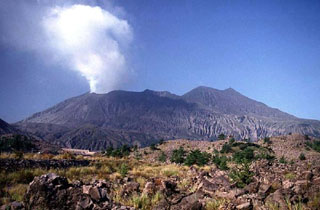Report on Aira (Japan) — 5 March-11 March 2025
Smithsonian Institution / US Geological Survey
Weekly Volcanic Activity Report, 5 March-11 March 2025
Managing Editor: Sally Sennert.
Please cite this report as:
Global Volcanism Program, 2025. Report on Aira (Japan) (Sennert, S, ed.). Weekly Volcanic Activity Report, 5 March-11 March 2025. Smithsonian Institution and US Geological Survey.
Aira
Japan
31.5772°N, 130.6589°E; summit elev. 1117 m
All times are local (unless otherwise noted)
The Japan Meteorological Agency (JMA) reported ongoing eruptive activity at Minamidake Crater (Aira Caldera’s Sakurajima volcano) during 3-10 March. Nightly crater incandescence was visible in webcam images. An explosion at 0523 on 4 March generated an ash plume that rose 1.5 km above the crater rim, drifted NE, and merged into weather clouds. The explosion ejected large blocks 600-900 m from the vent. Eruptive events at 0851 on 6 March, at 1640, 1704, 1808, and 2003 on 7 March, at 0031 on 8 March, and at 1525, 1645, and 1714 on 9 March generated ash plumes that rose 1-1.2 km above the crater rim and sometimes drifted NE or SE. Explosions at 1502 on 9 March and at 1124, 1604, and 2206 on 10 March produced ash plumes that rose as high as 1.3 km above the crater rim and drifted S and N. The explosion at 2206 on 10 March ejected blocks 600-900 m from the vent. The Alert Level remained at 3 (on a 5-level scale), and the public was warned to stay 1 km away from both craters.
Geological Summary. The Aira caldera in the northern half of Kagoshima Bay contains the post-caldera Sakurajima volcano, one of Japan's most active. Eruption of the voluminous Ito pyroclastic flow accompanied formation of the 17 x 23 km caldera about 22,000 years ago. The smaller Wakamiko caldera was formed during the early Holocene in the NE corner of the caldera, along with several post-caldera cones. The construction of Sakurajima began about 13,000 years ago on the southern rim and built an island that was joined to the Osumi Peninsula during the major explosive and effusive eruption of 1914. Activity at the Kitadake summit cone ended about 4,850 years ago, after which eruptions took place at Minamidake. Frequent eruptions since the 8th century have deposited ash on the city of Kagoshima, located across Kagoshima Bay only 8 km from the summit. The largest recorded eruption took place during 1471-76.

